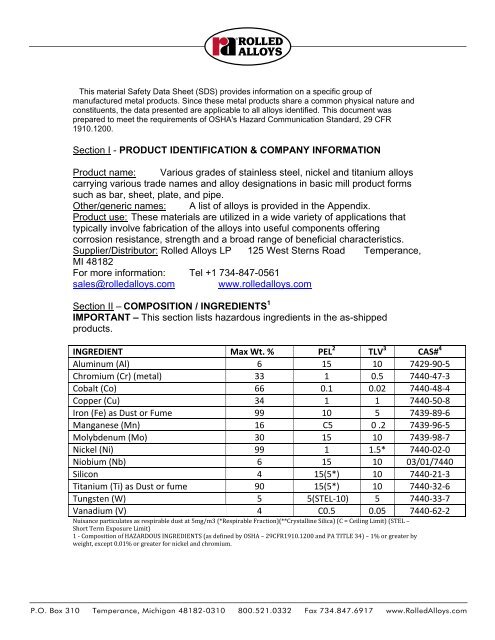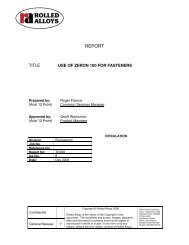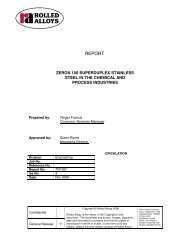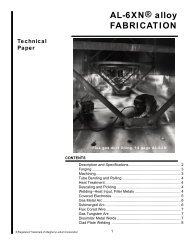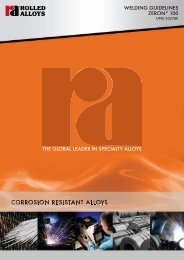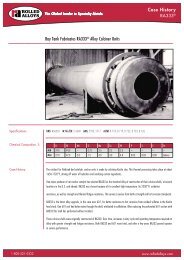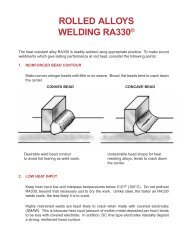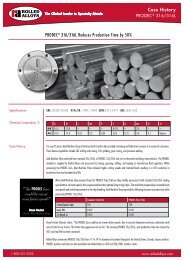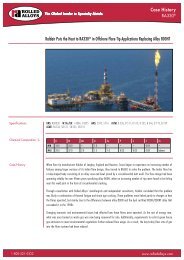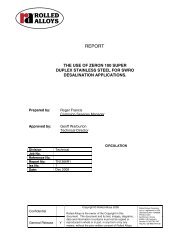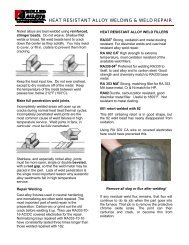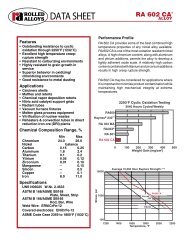General Product Safety Data Sheet - Rolled Alloys
General Product Safety Data Sheet - Rolled Alloys
General Product Safety Data Sheet - Rolled Alloys
Create successful ePaper yourself
Turn your PDF publications into a flip-book with our unique Google optimized e-Paper software.
This material <strong>Safety</strong> <strong>Data</strong> <strong>Sheet</strong> (SDS) provides information on a specific group of<br />
manufactured metal products. Since these metal products share a common physical nature and<br />
constituents, the data presented are applicable to all alloys identified. This document was<br />
prepared to meet the requirements of OSHA's Hazard Communication Standard, 29 CFR<br />
1910.1200.<br />
Section I - PRODUCT IDENTIFICATION & COMPANY INFORMATION<br />
<strong>Product</strong> name: Various grades of stainless steel, nickel and titanium alloys<br />
carrying various trade names and alloy designations in basic mill product forms<br />
such as bar, sheet, plate, and pipe.<br />
Other/generic names: A list of alloys is provided in the Appendix.<br />
<strong>Product</strong> use: These materials are utilized in a wide variety of applications that<br />
typically involve fabrication of the alloys into useful components offering<br />
corrosion resistance, strength and a broad range of beneficial characteristics.<br />
Supplier/Distributor: <strong>Rolled</strong> <strong>Alloys</strong> LP 125 West Sterns Road Temperance,<br />
MI 48182<br />
For more information: Tel +1 734-847-0561<br />
sales@rolledalloys.com www.rolledalloys.com<br />
Section II – COMPOSITION / INGREDIENTS 1<br />
IMPORTANT – This section lists hazardous ingredients in the as-shipped<br />
products.<br />
INGREDIENT Max Wt. % PEL 2 TLV 3 CAS# 4<br />
Aluminum (Al) 6 15 10 7429‐90‐5<br />
Chromium (Cr) (metal) 33 1 0.5 7440‐47‐3<br />
Cobalt (Co) 66 0.1 0.02 7440‐48‐4<br />
Copper (Cu) 34 1 1 7440‐50‐8<br />
Iron (Fe) as Dust or Fume 99 10 5 7439‐89‐6<br />
Manganese (Mn) 16 C5 0 .2 7439‐96‐5<br />
Molybdenum (Mo) 30 15 10 7439‐98‐7<br />
Nickel (Ni) 99 1 1.5* 7440‐02‐0<br />
Niobium (Nb) 6 15 10 03/01/7440<br />
Silicon 4 15(5*) 10 7440‐21‐3<br />
Titanium (Ti) as Dust or fume 90 15(5*) 10 7440‐32‐6<br />
Tungsten (W) 5 5(STEL‐10) 5 7440‐33‐7<br />
Vanadium (V) 4 C0.5 0.05 7440‐62‐2<br />
Nuisance particulates as respirable dust at 5mg/m3 (*Respirable Fraction)(**Crystalline Silica) (C = Ceiling Limit) (STEL –<br />
Short Term Exposure Limit)<br />
1 ‐ Composition of HAZARDOUS INGREDIENTS (as defined by OSHA – 29CFR1910.1200 and PA TITLE 34) – 1% or greater by<br />
weight, except 0.01% or greater for nickel and chromium.
2 ‐ OSHA Permissible Exposure Limits (mg/m3)<br />
3 ‐ Threshold Limit Value (mg/m3), American Conference of Governmental Industrial Hygienist (ACGIH)<br />
Both PEL and TLV are 8 hour Time Weighed Averages (TWA), unless designated as C (ceiling limits)<br />
4 ‐ Chemical Abstract Services Number<br />
Section III – HAZARDS IDENTIFICATION<br />
Solid metal alloys are not normally considered hazardous as shipped. Ends and<br />
edges can be sharp and gloves should be worn when handling.<br />
POTENTIAL HEALTH HAZARDS<br />
Skin: Although not normally hazardous, some individuals can develop allergic<br />
skin reactions to nickel and other metallic ingredients. Ends of wire and<br />
edges of strips may be sharp and can cause cuts. During welding and<br />
spraying - Fumes generated may be irritating to the skin. UV radiation<br />
produced can cause burns (ray burn). Hot metal can cause burns.<br />
Eyes: As shipped, product does not pose a hazard to the eyes however ends of<br />
wire and edges of strip are sharp and can cause cuts. During welding and<br />
spraying - Fumes generated can be irritating to the eye. Ends of wire may<br />
be sharp and can cause cuts or hot and cause burns. UV radiation<br />
produced can cause burns (arc eye).<br />
Inhalation: Fumes generated by welding and spraying processes can be irritating<br />
and toxic.<br />
Ingestion: Not a likely route of entry. Metal ingestion can cause toxic effects.<br />
Delayed effects: Inhalation of welding or spraying fumes may cause damage to<br />
the lungs and respiratory tract including but not limited to fibrosis of the<br />
lung which can reduce lung capacity and produce difficulty breathing.<br />
Cobalt and Nickel are animal carcinogens and inhalation of fumes and<br />
dusts should be avoided. Prolonged inhalation of Manganese fumes and<br />
dusts may cause irreversible damage to the nervous system resulting in<br />
Parkinson’s Disease-like symptoms (tremors, weakness, paralysis, etc.)<br />
Section IV – FIRST AID MEASURES<br />
Skin: Wash skin with soap and water to remove any metallic particles. If a rash or<br />
burn develops, seek medical attention.<br />
Eyes: Flush particles from eyes with clean water for at least 15 minutes. If<br />
irritation persists or burn develops, seek medical attention.<br />
Inhalation: Remove from exposure. If respiratory irritation persists, seek medical<br />
attention.<br />
Ingestion: If metallic particles are swallowed, seek medical assistance.<br />
Advice to physician: Treat symptomatically
Section V – FIRE FIGHTING MEASURES<br />
As shipped, these products are nonflammable and non-explosive. If subjected to<br />
fabrication by welding, however, welding arcs and sparks can ignite<br />
combustibles, and can initiate fires and explosions. Be sure you read and<br />
understand American National Standard Institute standard ANSI Z49.1 "<strong>Safety</strong> in<br />
Welding and Cutting" and National Fire Protection Association standard 51B for<br />
fire prevention in "Cutting and Welding Processes" before using these products.<br />
Extinguishing<br />
N/A<br />
Unusual Fire and Explosive Hazards<br />
N/A<br />
Special Fire Fighting Procedures<br />
N/A<br />
Media Flash Point (Method Used)<br />
N/A<br />
Flammable Limit<br />
N/A<br />
Section VI – ACCIDENTAL RELEASE MEASURES<br />
In solid form this material poses no special clean-up problems. If this material is<br />
in powder or dust form, notify safety personnel, isolate the area and deny entry.<br />
Do not sweep. Clean-up should be conducted with a vacuum system utilizing a<br />
high efficiency particulate air (HEPA) filtration system. Caution should be taken to<br />
minimize airborne generation of powder or dust and avoid contamination of air<br />
and water. Cleanup personnel should protect against exposure. Properly label all<br />
materials collected in waste container. Follow applicable emergency response<br />
regulations, such as OSHA (29CFR 1910.120).<br />
Section VII – HANDLING AND STORAGE<br />
HANDLING PRECAUTIONS - Dust and welding fume should be moved or<br />
transported to minimize spill or release potential.<br />
STORAGE PRECAUTIONS - In solid form, these materials pose no hazards.<br />
Section VIII – EXPOSURE CONTROLS/PERSONAL PROTECTION<br />
ENGINEERING CONTROLS - Local exhaust ventilation should be used to<br />
control exposure to airborne dust and fume emissions near the source (during<br />
welding, plasma arc cutting, sawing, grinding, etc.) below the exposure limits<br />
cited in Section 2.<br />
RESPIRATORY PROTECTION - Use a fume respirator or an air supplied<br />
respirator where local exhaust or general ventilation does not keep exposure
elow the exposure limits for air contamination. Use NIOSH approved respirators<br />
as specified by an industrial hygienist or qualified safety professional. Lung<br />
function tests are recommended for users of negative pressure devices.<br />
GLOVES/ARMS - Wear suitable protection while handling solid metal alloys in<br />
mill product forms to protect against physical injury.<br />
EYE PROTECTION – Wear safety glasses or goggles when there is a<br />
reasonable probability of flying particles or high levels of airborne dust. If welding<br />
these materials be aware that welding arcs produce ultraviolet and infrared<br />
radiation.<br />
RECOMMENDED MONITORING PROCEDURES - The welding fumes of most<br />
of these welding products contain certain ingredients which either may, or will,<br />
reach their PEL TLV ®, or other occupational exposure limit before reaching the<br />
TLV ®-TWA of 5 mg/m3 for respirable particulate not otherwise specified (NOS).<br />
Monitoring the welding fume for these ingredients is recommended. Monitoring<br />
for respirable particulate (NOC) is also recommended for all products. Seek<br />
professional advice from an industrial hygienist or qualified safety professional for<br />
recommended monitoring procedures.<br />
Section IX – PHYSICAL AND CHEMICAL PROPERTIES<br />
MELTING POINT: >2100°F
fumes.<br />
Section XI – TOXICOLOGICAL INFORMATION<br />
Nickel and cobalt are classified as Category 3 carcinogens. The exposure route<br />
of concern is inhalation.<br />
As shipped, these complex alloys in massive form have no known toxicological<br />
properties other than causing allergic reactions in individuals sensitive to the<br />
metal(s) contained in the alloys. However, dust from flux or user-generated dusts<br />
and fumes may on contact with the skin or eyes produce mechanical irritation.<br />
Chronic exposures coupled with sweat could cause dermatitis (skin) or<br />
conjunctivitis (eyes).<br />
Excessive inhalation of dust or user-generated fumes from welding or metal<br />
spraying may, depending on the specific features of the process used, pose a<br />
long-term health hazard. The International Agency for Research on Cancer<br />
(IARC) has concluded that welding fumes are possibly carcinogenic to humans.<br />
The ingredients of fumes and gases generated in welding, metals spraying and<br />
grinding will depend on the base metal and the details of the specific process<br />
being used. Ingredients may include metals, metal oxides, chromates, fluorides,<br />
carbon monoxide, ozone, and oxides of nitrogen.<br />
DELAYED (SUBCHRONIC AND CHRONIC) EFFECTS:<br />
Chromium - The International Agency for Research on Cancer (IARC) considers<br />
hexavalent chromium to be a carcinogen (lung, nasal) but does not have<br />
adequate evidence for chromium metal and trivalent chromium. Fumes have<br />
been associated with lung fibrosis.<br />
Iron - Prolonged inhalation of iron oxide fumes can lead to siderosis, which<br />
presents as a benign pneumoconiosis.<br />
Molybdenum - Repeated inhalation of fumes has caused kidney damage,<br />
respiratory irritation and liver damage in animals.<br />
Nickel - Nickel metal is “reasonably anticipated to be a human carcinogen”<br />
(National Toxicology Program’s 10th Report). IARC states that nickel metal is<br />
possibly carcinogenic to humans. Epidemiological studies of workers exposed to<br />
nickel powders, dusts and fumes in the nickel alloy and stainless steel producing<br />
industries do not indicate a significant respiratory cancer hazard. Inhalation of<br />
nickel powder produced malignant tumors in rodent studies. Single intratracheal<br />
installations of nickel powder at levels close to the LD50 have caused<br />
malignancies in hamsters. Nickel can cause skin sensitization in susceptible<br />
individuals through prolonged contact with skin.<br />
Section XII – ECOLOGICAL INFORMATION
Solid metal alloys in mill product forms products are not considered toxic to<br />
aquatic species. It is believed that finely divided product, based on its<br />
components, will be hazardous to fish, animals, plants and the environment if<br />
released, the degree of which would depend on the particle size and quantity<br />
released. In addition, if particles are small enough, material may be ingested by<br />
wildlife, with possible toxic effects. The solid product is not expected to migrate<br />
easily into soil or groundwater based upon its insoluble form, however, finely<br />
divided material can become mobile in water and contaminate soil and<br />
groundwater.<br />
Section XIII – DISPOSAL CONSIDERATIONS<br />
If as shipped products become solid waste, they would not be classified as a<br />
hazardous waste and are normally collected to recover metal values. Dispose of<br />
dust, fume, and grinding and cutting residues from the work area, or from filters,<br />
in accordance with local, state and federal regulations. Refer to this SDS for<br />
information on the possible contents of the collected fumes and other materials.<br />
Section XIV – TRANSPORT INFORMATION<br />
No international regulations or restrictions are applicable.<br />
SHIPPING NAME -<br />
Not Applicable<br />
IDENTIFICATION NUMBER - Not Applicable<br />
HAZARD CLASS -<br />
Not Applicable<br />
LABEL(S) REQUIRED - Not Applicable<br />
Section XV – REGULATORY INFORMATION<br />
<strong>Alloys</strong> containing less than 1% of nickel or cobalt are not classified as<br />
"dangerous for supply". <strong>Alloys</strong> containing more than 1% of either metal are<br />
classified as the metals themselves. However, in recognition of their essentially<br />
non-hazardous nature, these alloys in the massive form are not required to be<br />
labeled as hazardous.<br />
Section XVI – OTHER INFORMATION<br />
Current Issue Date: September 2013<br />
Previous Issue Date:<br />
August 2010<br />
Changes: MSDS to SDS, Added Zeron100<br />
Previous Changes: Change of format which includes additional information
This SDS was prepared by <strong>Rolled</strong> <strong>Alloys</strong> technical personnel to be in compliance<br />
with OSHA's Hazard Communication Standard, 29 CFR 1910.1200 and is<br />
provided in good faith based upon the experience and knowledge of the<br />
company. <strong>Rolled</strong> <strong>Alloys</strong> does not manufacture solid metal alloys, but causes<br />
products to be made under their label by internationally known and recognized<br />
producers. In addition, <strong>Rolled</strong> <strong>Alloys</strong> distributes products of these companies<br />
and has relied, in part, on information contained in SDS documents provided by<br />
these manufacturers. Users should make their own assessment of workplace<br />
risks as required by other health and safety legislation. As the conditions or<br />
methods of use are beyond our control, we do not assume any responsibility and<br />
expressly disclaim any liability for any material described herein. Information<br />
contained herein is believed to be true and accurate, but all statements or<br />
suggestions are made without warranty, expressed or implied, regarding<br />
accuracy of the information, the hazards connected with the use of the material<br />
or the results to be obtained from the use thereof. Compliance with all applicable<br />
Federal, State, and local laws and regulations remain the responsibility of the<br />
user.
APPENDIX<br />
This listing of alloys represents the common or trade name of the materials<br />
commonly supplied by <strong>Rolled</strong> <strong>Alloys</strong>. <strong>Rolled</strong> <strong>Alloys</strong> may, from time to time,<br />
supply similar alloys that are not included on this list. The composition of these<br />
other materials will fall within the compositions ranges shown in Section II of the<br />
SDS.<br />
Titanium <strong>Alloys</strong><br />
6-4 UNS: R56400 6-4 ELI UNS: R56401 6-4 STA<br />
UNS: R56400<br />
6-2-4-2 UNS: R54620 6-6-2 UNS: R56620 10-2-3 UNS:<br />
R56410<br />
Duplex Stainless Steels<br />
ZERON® 100 UNS: S32760<br />
ZERON® 100 FG UNS: S32760<br />
2205 UNS: S31803, S32205 LDX 2101® UNS: S32101<br />
Nickel<strong>Alloys</strong><br />
RA330® UNS: N08330 RA333® UNS: N06333<br />
RA 602 CA® UNS: N06025 600 UNS: N06600 601 UNS:<br />
N06601<br />
800H/AT UNS: N08810, N08811<br />
AL-6XN® UNS: N08367<br />
625 UNS: N06625 Alloy 20 UNS: N08020 718 UNS:<br />
N07718<br />
718 NACE UNS: N07718 X UNS: N06002 230® UNS:<br />
N06230<br />
W UNS: N10004<br />
INVAR 36 UNS: K93600, K93603<br />
Cobalt <strong>Alloys</strong><br />
188 UNS: R30188 L-605 UNS: R30605 René 41<br />
UNS: N07041<br />
Waspaloy UNS: N07001 C263 UNS: N07263 694 (CM-64)<br />
TRIBALOY® T-800®<br />
Stainless Steels<br />
RA 253 MA® UNS: S30815 310 UNS: S31008, S31009 309 UNS:<br />
S30908<br />
321 UNS: S32100 347 UNS: S34700 410 UNS:<br />
S41000
410S UNS: S41008 446 UNS: S44600 317L UNS:<br />
S31703<br />
303* UNS: S30300 304/304H UNS: S30400, S30409<br />
304/304L* UNS: S30400, S30403<br />
316/316L* UNS: S31600, S31603<br />
17-4 UNS: S17400 15-5 UNS: S15500 A-286 UNS:<br />
S66286<br />
Zeron®100 S32760<br />
* 303, 304/304L, 316/316L are also featured as <strong>Rolled</strong> <strong>Alloys</strong> Machining Quality<br />
Bar, also known as RAM<br />
RA, RA330, RA333 and ZERON are registered trademarks of <strong>Rolled</strong> <strong>Alloys</strong> • 602 C A is a registered trademark of<br />
Thyssen Krupp VDM • AL-6XN is a registered trademark of ATI Properties, Inc•253 M A and LDX 2101 are registered<br />
trademarks of Outokumpu Stainless • 23 0 is a registered trademark of Haynes International • TRIBALOY and T-800 are<br />
registered trademarks of Deloro Stellite® Zeron is a registered trademark of <strong>Rolled</strong> <strong>Alloys</strong>


